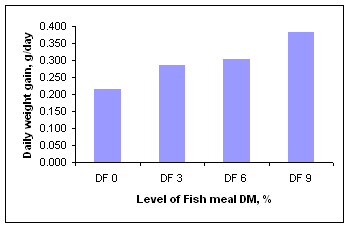The effects of water spinach on growing crossbred pigs
Prak Kea, T R Preston*, Chhum Phith Loan** and Kong
Rada***
RoyalUniversity of Agriculture,
Faculty of Animal Science and Veterinary
Medicine
prakkea@yahoo.com / prakkea@hotmail.com
* University of Tropical Agriculture
Foundation
regpreston@utafoundation.org
** Royal University of Agriculture,
Faculty of Animal Science and Veterinary Medicine
loan@hotmail.com
*** Royal University of Agriculture,
Faculty of Animal Science and Veterinary
Medicine
Introduction
Feed is the key factor for improving pig productivity. When there is a lack of feed resources for feeding pigs this will cause them to grow slowly and the result is a decrease of the income. Thus many researchers in developing countries try to find the way to improve the pig performance by making better use of the available feed resources.
As Cambodia is an agrarian country, there are large amounts of rice by-products, such as rice bran, broken rice, and also vegetables are traditionally used for pig raising throughout the country.
The large water surface areas have brought potential advantages
to farmers by allowing the cultivation of water spinach all year
round for human food and for feeding to animals. According to Le
Thi Men et al (1999), annual yields can be as high as 455 tonnes
fresh biomass (about 40 tonnes DM) per ha from 17 three-week
vegetative cycles a yield of 24 tonnes/ha in only 30 days after
sowing the seed was reported by Kean Sophea et al (2001). The fresh
leaves and stems of water spinach have a high crude protein content
in the range of 18 to 31% in dry matter (Le Thi Men et al 2000; Bui
Huy Nhu Phuc 2000; Prak Kea et al 2003). The plant is also rich in
minerals with an ash content of 12% in dry matter (Göhl 1998;
Bui Huy Nhu Phuc 2000; Prak Kea et al 2003). It has been used
successfully to replace part of the protein in sugar cane juice
diets for breeding sows (Le Thi Men and Bui Hong Van 1993) and as
the main protein source for growing pigs fed broken rice (Ly 2001;
Prak Kea 2003). On an annual basis protein yields of between 4 and
6 tonnes/ha appear to be possible. This high yield potential
enables farmers to get a regular high income from harvesting water
spinach and selling it to local markets.
Although water spinach has a high protein content its digestibility is rather low. According to Ly et al (2002), the in vitro digestibility of the nitrogen is only 56% compared with 75% in duckweed. The low energy density in water spinach is another limitation and could be corrected by supplementation with energy-rich feeds such as cassava root meal. The protein in water spinach, as in other plant proteins, is deficient in sulphur amino acids, thus dried fresh water fish, available locally in Cambodia, would be a logical supplement to complement the protein in water spinach.
The aims of the research
This research aims to determine the effect on feed intake,
apparent digestibility, N retention and growth rate by crossbred
pigs, of different ratios of fish meal and water spinach as protein
sources in basal diets of cassava root meal and rice bran.
Materials and methods
Location and duration
The research is conducting at the animal farm of the Faculty of Animal Science and Veterinary Medicine located in the campus of the Royal University of Agriculture, about 12 km from Phnom Penh city. This research is starting from 08 March 2004, it still continuing and will last until August 2004.
Experimental design
This experiment is using cassava root meal (CRM) and rice bran (RB) as the basal diet with the protein supplied by mixtures of water spinach (WS) and dried fish meal (fish meal levels of 0, 3, 6 and 9%), arranged according to a randomized complete block (RCBD) to measure performance traits in growing pigs. The feed composition and levels of supplementation is revealed in table below.
The composition of the diets is in Table 1.
|
Table 1: Composition of the diets (% in
DM) |
||||
|
|
Level of fish meal, % in DM |
|||
|
|
DF0 |
DF3 |
DF6 |
DF9 |
|
DF |
0 |
3 |
6 |
9 |
|
WS |
38 |
30 |
21 |
13 |
|
RB |
32 |
37 |
43 |
48 |
|
CRM |
29 |
29 |
29 |
29 |
|
Minerals |
1 |
1 |
1 |
1 |
|
CP in DM, % |
12.2 |
12.2 |
12.1 |
12.2 |
Feeding and Management
The pigs were weighed once every two weeks in the morning
before feeding and will stop the experiment at a mean liveweight of
70 kg. Daily gains were calculated from the linear regression of liveweight on days on
trial.
Data on feed offered and refusals will be collected and
recorded every day to estimate the intake. Faeces are collected
during one day every two weeks and kept in the plastic bucket
stored in the freezer at -20 ºC. At the end of the experiment,
the samples will be analyzed for DM, crude protein, neutral
detergent fibre, crude fiber and ash in feed offered and refused
and in faeces. The chemical analysis will be done following
standard procedures according to AOAC (1988) except for DM which
was determined by micro-wave radiation (Undersander et al 1993).
Neutral detergent fibre (NDF) is determined according to Van Soest
et al (1991).
Statistical analyses
The data was analyzed using the General Linear Model (GLM) of the ANOVA programme in the MINITAB software version 13.31 (Minitab 2000). Sources of variation are treatments, sex, blocks, the interaction treatments*sex and error.
Results
Growth performance
During the first two months, live weight gains were higher for castrate males than for females and increased in accordance with the level of fish meal (Figure 1).

Figure 1: The daily weight gain of the pigs during the first 2 months of the experiment